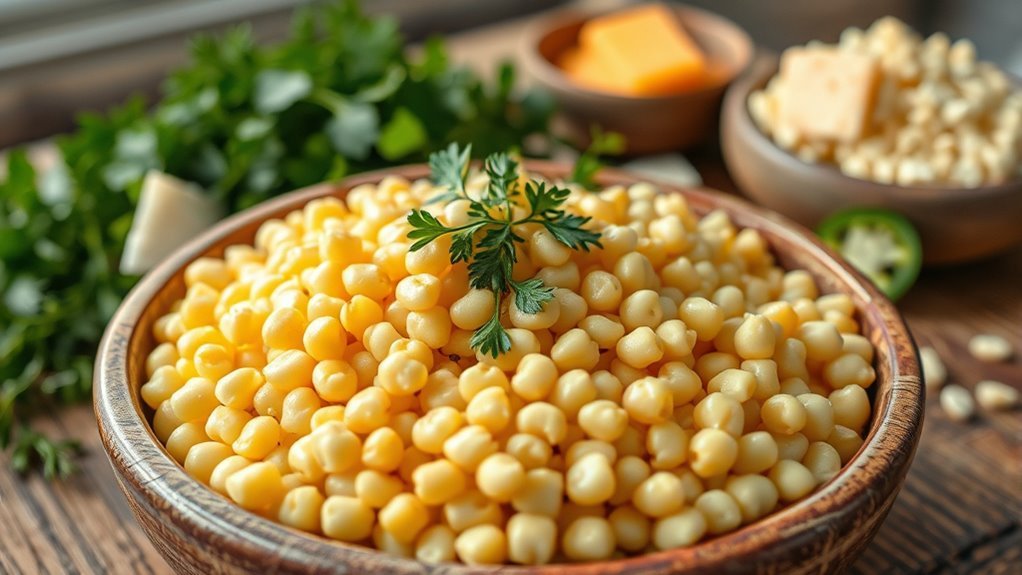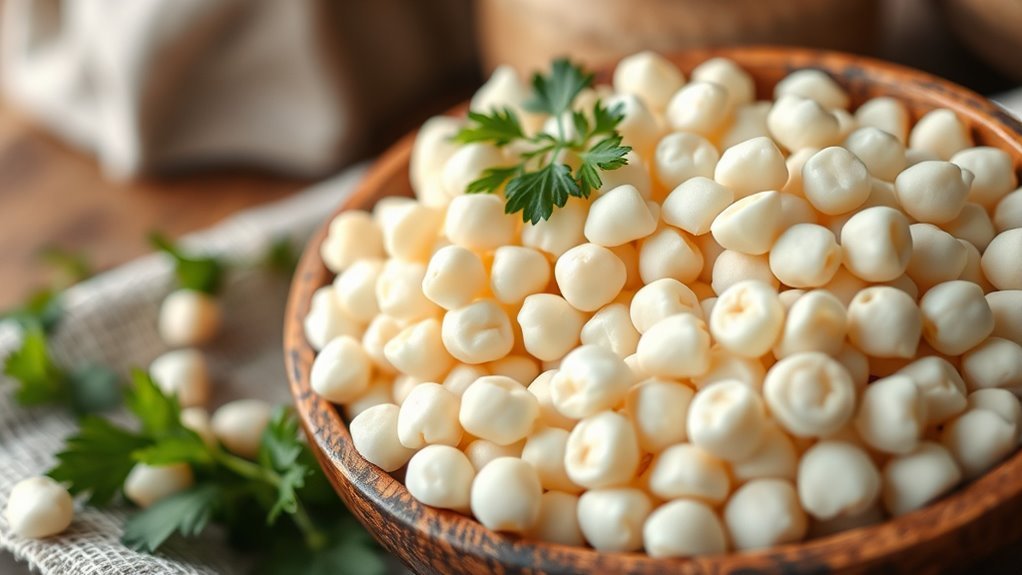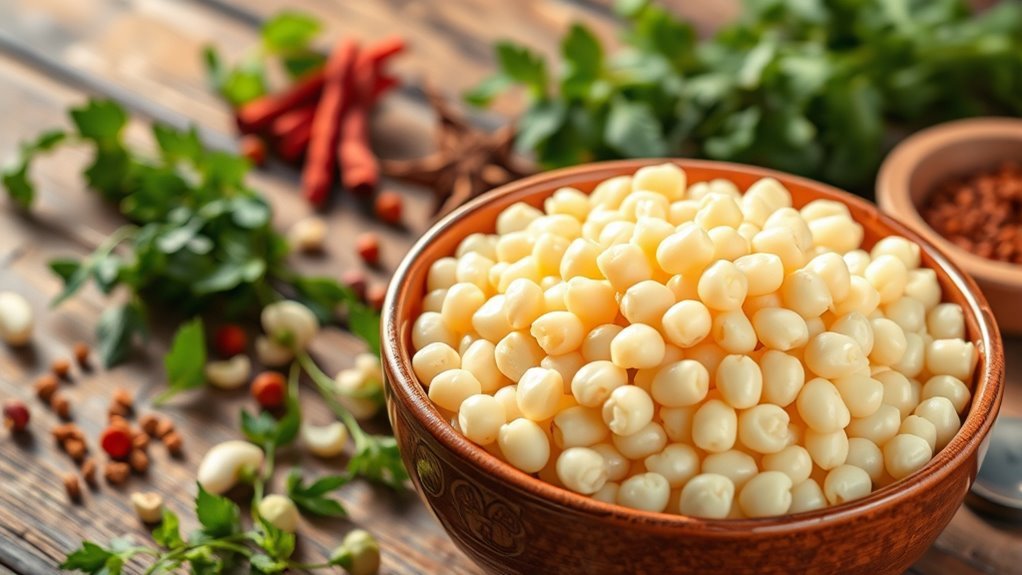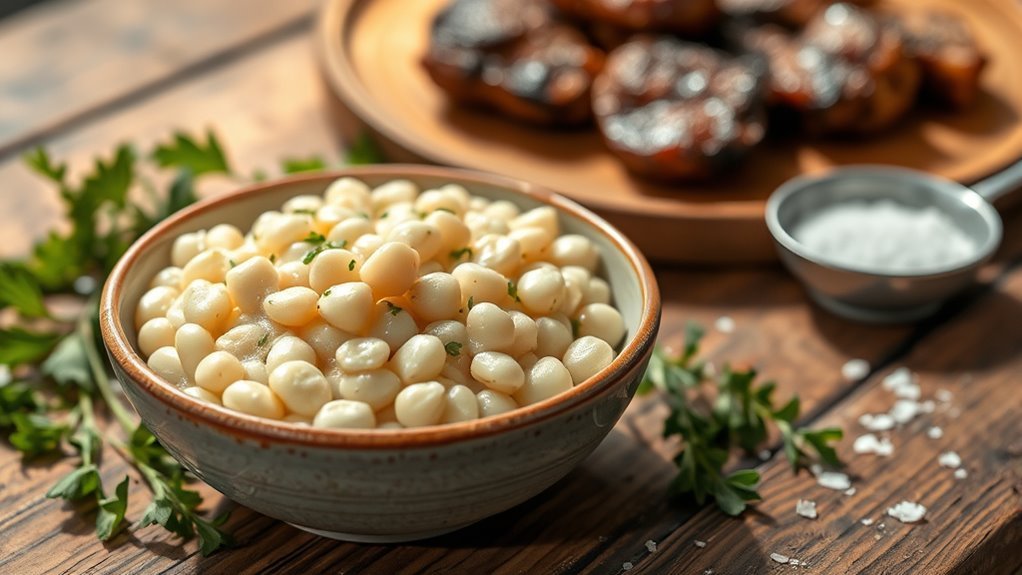Hominy isn’t generally considered keto-friendly due to its carbohydrate content, which can be around 20 grams per serving. While it offers nutritional benefits like fiber and essential vitamins, it’s higher in carbs compared to other low-carb options. If you’re on a strict keto diet, it’s important to be mindful of your intake. However, you can still incorporate it creatively in small amounts or find suitable alternatives to enhance your meals. Learn more about balancing your diet with hominy options and substitutes.
Understanding Hominy: What Is It?

Hominy, a unique food product made from dried corn kernels, undergoes a process called nixtamalization, where the corn is soaked and cooked in an alkaline solution. This method not only enhances the flavor but also improves the nutritional value, making it a staple in various cuisines, particularly in Mexican and Southern cooking. The origins of hominy trace back to Indigenous peoples, who recognized its potential as a versatile ingredient. When it comes to hominy preparation, you’ll find it can be used in soups, stews, or as a side dish, providing a chewy texture and distinct taste. Whether you’re exploring traditional recipes or creating new dishes, understanding hominy opens up a world of culinary possibilities.
Nutritional Profile of Hominy

When considering the nutritional profile of hominy, it’s important to note that it offers a blend of carbohydrates, fiber, and essential nutrients. One of the key hominy benefits is its high dietary fiber content, which can support digestive health and help you feel full longer. This makes it a great addition to meals if you’re looking to manage your appetite. Additionally, hominy contains important vitamins and minerals, including B vitamins and magnesium, contributing to overall well-being. While it’s not a low-carb food, its fiber content can aid in moderating blood sugar levels. So, if you’re exploring options for a balanced diet, hominy can be a nutritious choice in moderation.
Carbohydrate Content in Hominy

The carbohydrate content in hominy is an essential factor to take into account for those following a keto diet. Hominy, made from treated corn, generally has a higher carb count than other keto-friendly foods. A typical serving can contain around 20 grams of carbohydrates, which can quickly add up if you’re trying to stay under your daily limit. While it does offer some health benefits, like fiber and certain vitamins, those benefits may not outweigh the carb considerations for strict keto dieters. If you’re considering incorporating hominy into your meals, be mindful of your overall carb intake and how it fits into your dietary goals. Balancing your meals will help you maintain freedom in your food choices while adhering to your lifestyle.
How Hominy Compares to Other Corn Products
While many people enjoy corn products for their flavor and versatility, it’s important to compare their nutritional profiles to understand how hominy stacks up against its counterparts. Here’s a quick comparison:
| Corn Product | Carbs (per 100g) |
|---|---|
| Hominy | 22g |
| Cornmeal | 73g |
| Corn Tortilla | 50g |
| Popcorn | 78g |
| Sweet Corn | 19g |
Hominy benefits from being lower in carbs compared to most corn alternatives, making it a more appealing option for those watching their carbohydrate intake. Understanding these differences can help you make informed choices about including hominy in your diet while exploring other corn products.
Incorporating Hominy Into a Keto Diet
Incorporating hominy into a keto diet can be a flavorful way to diversify your meals without straying too far from your carb limits. While traditional hominy contains more carbs than other keto-friendly foods, you can use it sparingly in creative keto recipes. Consider adding small amounts to soups or stews for texture and flavor. If you’re concerned about carb counts, explore hominy substitutes like cauliflower or zucchini to maintain that hearty feel with fewer carbs. By balancing your portions and combining hominy with high-fat ingredients, you can enjoy its unique taste while staying within your dietary goals. Remember, it’s all about finding that balance and enjoying the freedom to experiment in your kitchen!
Alternatives to Hominy for Keto Enthusiasts
If you’re looking for keto-friendly alternatives to hominy, several options can provide similar textures and flavors without the high carb content. Cauliflower rice is a popular choice; it mimics the grainy texture of hominy while being low in carbs. You can easily sauté or steam it to enhance its flavor. Zucchini noodles, or “zoodles,” are another excellent alternative. They offer a satisfying bite and can be used in a variety of dishes, from stir-fries to pasta substitutes. Both options are versatile, allowing you to experiment with different seasonings and sauces, ensuring you stay within your carb limits while enjoying delicious meals. These alternatives can help you maintain your keto lifestyle without feeling deprived.
Frequently Asked Questions
Can Hominy Be Eaten on a Low-Carb Diet?
If you’re considering low-carb alternatives, hominy might not be your best option. While it offers some nutritional benefits, it’s relatively high in carbohydrates compared to other choices. With around 36 grams of carbs per cup, it can quickly impact your carb intake. If you’re committed to a low-carb diet, you might want to explore other options like cauliflower rice or zucchini noodles that align better with your goals while providing essential nutrients.
Is Canned Hominy Keto-Friendly?
When you’re considering canned hominy on a keto diet, it’s important to check the carb content. Canned hominy typically contains about 30 grams of carbs per cup, which can be quite high for a low-carb lifestyle. While it’s tasty and can add variety to your meals, you might want to enjoy it in moderation or look for alternatives that fit better within your carb limits. Always prioritize your dietary goals!
How Is Hominy Made?
Hominy’s made through a process called nixtamalization, where dried corn kernels are soaked in an alkaline solution, usually limewater. This not only softens the corn but also enhances its nutritional value. After soaking, the kernels are rinsed and can be cooked in various ways, like boiling or frying. Hominy production varies regionally, with different cooking methods giving it unique textures and flavors. You’ll appreciate the versatility it adds to your meals!
What Dishes Traditionally Use Hominy?
Did you know that over 80% of traditional Mexican dishes feature corn in some form? Hominy, made from dried corn kernels, plays a starring role in numerous hominy recipes. You’ll find it in classic dishes like pozole, a hearty soup often garnished with fresh toppings, and in grits, a Southern staple. These traditional dishes showcase hominy’s versatility, bringing rich flavors and textures that have delighted palates for generations.
Are There Any Health Benefits to Eating Hominy?
When considering the health benefits of eating hominy, you’ll find it offers some nutritional value, including fiber and essential vitamins. However, you should also be aware of potential health risks, especially if you have sensitivities to corn or certain digestive issues. Moderation is key, and balancing hominy with other nutrient-dense foods can help you enjoy its benefits while managing any risks. Just remember to listen to your body’s needs.


